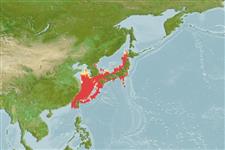分类 / Names
俗名 | 同种异名 | Catalog of Fishes(属, 种) | ITIS | CoL | WoRMS | Cloffa
Elasmobranchii
板鳃亚纲 (鲨鱼与 鱼) (sharks and rays) >
Squatiniformes (Angel sharks)
琵琶鮫目 (Angel sharks) >
Squatinidae (Angel sharks)
琵琶鮫科(Angel sharks) (Angel sharks)
Etymology: Squatina: Latin for skate, which angel sharks superficially resemble, presumably tautonymous with Squalus squatina Linnaeus 1758 (no species mentioned). (See ETYFish); nebulosa: Latin for cloudy or dark, referring to its brown-black marbled coloration. (See ETYFish).
More on author: Regan.
Environment: milieu / climate zone / depth range / distribution range
生态学
海洋 居于水底的; 深度上下限 0 - 200 m (Ref. 54907). 深水域; 47°N - 22°N, 119°E - 142°E (Ref. 54907)
Northwest Pacific: southeastern Sea of Japan to Taiwan, including Japan, Korea, China. Reported from the northern shelf of the South China Sea (Ref. 12082).
西北太平洋: 日本海東南方到台灣,包括日本,韓國,中國。 記錄來自南中國海的大陸棚北部了。 (參考文獻 12082)
大小 / 重量 / 年龄
Maturity: Lm ? range ? - ? cm
Max length : 163.0 cm TL (female)
Found on the continental shelves. Ovoviviparous (Ref. 50449).
栖息于大陆架了。 卵胎生的.(参考文献 50449)
Life cycle and mating behavior
Maturities | 繁殖 | Spawnings | Egg(s) | Fecundities | 仔鱼
Ovoviviparous, embryos feed solely on yolk (Ref. 50449).西北太平洋: 日本海東南方到台灣,包括日本,韓國,中國。 記錄來自南中國海的大陸棚北部了。 (參考文獻 12082)
Compagno, L.J.V., 1984. FAO Species Catalogue. Vol. 4. Sharks of the world. An annotated and illustrated catalogue of shark species known to date. Part 1 - Hexanchiformes to Lamniformes. FAO Fish. Synop. 125(4/1):1-249. Rome, FAO. (Ref. 247)
世界自然保护联盟红皮书 (Ref. 130435)
濒危 (EN) (A2d); Date assessed: 22 August 2018
人类利用
工具
特别资料
下载 XML
网络资源
Estimates based on models
Preferred temperature (Ref.
123201): 11.8 - 23.5, mean 18.1 °C (based on 106 cells).
Phylogenetic diversity index (Ref.
82804): PD
50 = 0.5000 [Uniqueness, from 0.5 = low to 2.0 = high].
Bayesian length-weight: a=0.00676 (0.00293 - 0.01558), b=3.07 (2.88 - 3.26), in cm total length, based on LWR estimates for this Genus-body shape (Ref.
93245).
营养阶层 (Ref.
69278): 4.1 ±0.6 se; based on size and trophs of closest relatives
回复力 (Ref.
120179): 低的, 最小族群倍增时间4.5 - 14 年 (Fec assumed to be <100).
Fishing Vulnerability (Ref.
59153): Very high vulnerability (90 of 100).
